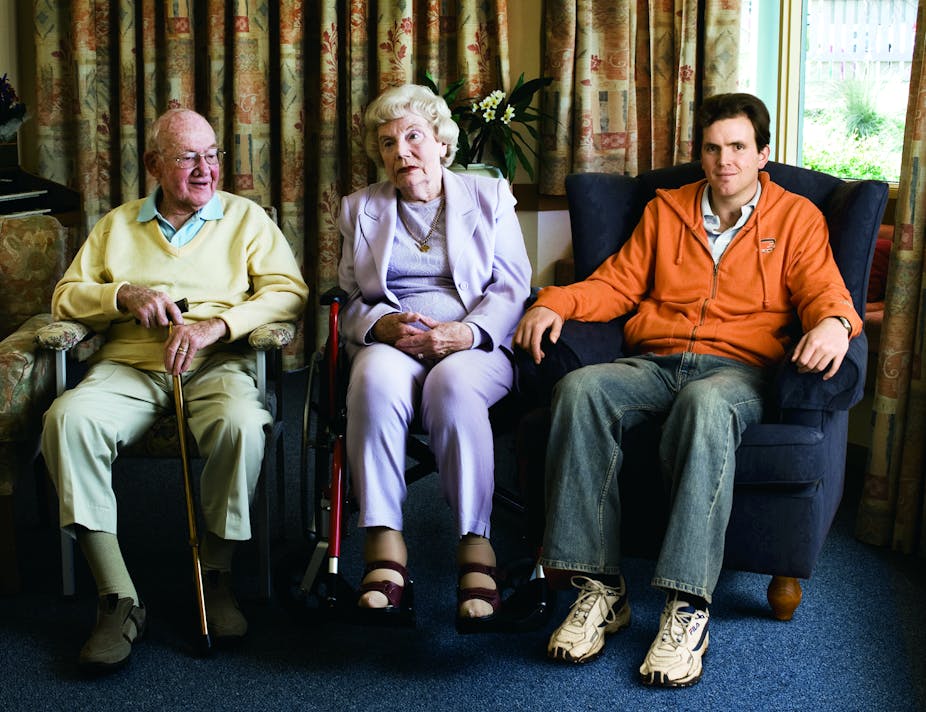Michelle Newland was 19 years old when she had a severe asthma attack that left her with hypoxic brain injury. After eight weeks, the hospital staff told Michelle’s parents that she was not suitable for rehabilitation and the family should look for a nursing home placement. Michelle spent 18 months living in an aged care facility, where she mostly lay in bed.
Unfortunately, this isn’t a unique scenario. More than 600 Australians aged under 50 who have a disability currently live in nursing homes. The facilities aren’t tailored to their needs and effectively isolate them from society.
Just under half (42%) of young people in aged care facilities aren’t ever visited by their friends. And one third (33%) never have the opportunity to participate in community-based activities such as shopping, seeing movies, or visiting friends and family.
Finding solutions
In 2006, the Council of Australian Governments funded a five-year, $244 million Younger People with Disability in Residential Aged Care initiative. The program helped around 250 people to move out of aged care and a further 244 to avoid being admitted in the first place. Those assisted reported marked improvements in their quality of life, as well as opportunities to make everyday choices and participate in community activities.
But since this program ceased mid last year, the system has largely begun reverting to past practices. Younger people are again being placed in nursing homes, with more than 200 young people at risk of admission to aged care in Australia each year.
The issue of young people in nursing homes is one clear reason we need the National Disability Insurance Scheme (NDIS). The $1bn announced in the federal budget to trial the NDIS over the next four years will provide the funding for disability supports this group requires to live in the community. But the NDIS is not a silver bullet.
Other pressures
One reason people like Michelle end up in nursing homes is because of the pressure on hospital staff to free up beds once patients are medically stable.
We need services that prevent new admissions to aged care and create pathways back to community living. Slow stream rehabilitation and transitional services need to be developed to give people with severe brain injuries in acute hospitals the time they need to demonstrate their potential before they are forced into nursing homes.

We also need more age-appropriate and innovative supported housing options. This is coming but remains under-funded.
Last month, the Commonwealth government announced that 21 organisations across Australia would share in the $60 million Supported Accommodation Innovation Fund (SAIF) to develop accommodation and respite for people with disability by mid-2014.
Much of the housing will be smaller scale and more family friendly than tradtional “group homes”, including clusters of units and apartments peppered throughout larger developments. Most young people in nursing homes acquired their disability as adults – with almost half (48%) having partners and a quarter (27%) with school age children – so this innovation and small-scale design is particularly important.
But given the high demand for supported accommodation, the SAIF will only assist a small proportion of those in need. In Victoria, for instance, there were 1,239 people with disability with a critical need for supported accommodation in June 2010. The SAIF will provide new accommodation for 53 people with disability in Victoria, addressing the needs of just 4% of this group.
Realising the potential
Michelle demonstrates the potential of people with an acquired brain injury. Michelle’s parents couldn’t bear to see her deteriorating in a nursing home - they turned their lives upside down and took Michelle home.
Through her hard work and the tenacity and support of her parents, Michelle has regained her continence and re-learnt to talk, swallow, read, dress, walk and swim. Ten years since her brain injury, Michelle makes a significant contribution to society by volunteering in two local primary schools and speaking to high school students and community groups.
Michelle would never have realised her potential languishing in a nursing home. So it’s sobering to consider the 200 other young people who will be admitted to aged care in Australia this year with just as much potential as Michelle.
Next steps
Ideally, the implementation of the NDIS will be accompanied by the development of systemic change and services that enable other people with severe brain injury to maximise their independence and potential. Unlike the current crisis-driven and reactive disability service system, the scheme must provide early intervention and pre-emptive support to minimise the impact of disability on individuals and their families.
Effective implementation of the NDIS, coupled with alternate care pathways and more innovative housing options, will resolve the issue of young people in nursing homes. This will not only decrease their lifetime care costs – it will bring more young people with disabilities back into the mainstream so that they can make their own unique contribution to society.

